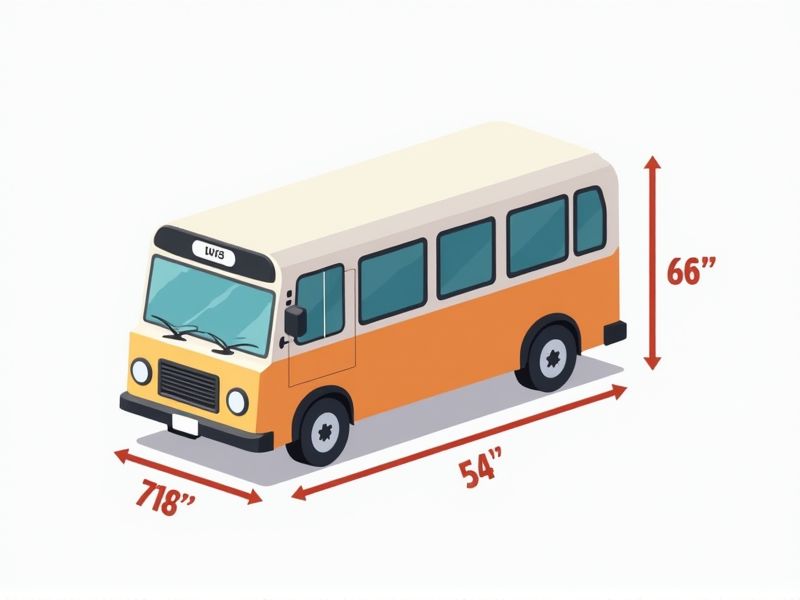
The standard dimensions of a typical city bus are designed for both passenger comfort and road regulations. Most city buses are approximately 12 meters (about 40 feet) in length, 2.5 meters (about 8.2 feet) wide, and roughly 3 meters (about 10 feet) in height. These dimensions accommodate about 40-60 seats, with additional standing room for passengers. It's helpful to note that these measurements can vary based on the specific type of bus (such as mini, midi, or articulated buses) and regional transportation requirements.
Length: 40-45 Feet
Buses typically range from 40 to 45 feet in length, making them ideal for urban and suburban transportation. This size allows for a capacity of approximately 40 to 80 passengers, depending on the seating configuration, enhancing efficiency in public transit systems. The choice of a 40 to 45-foot length ensures maneuverability in city streets while providing ample space for commuters. When planning your transportation needs, consider how this bus size can accommodate significant passenger volumes effectively.
Width: 8.5 Feet
The standard width of a bus is 8.5 feet, which enhances passenger comfort and safety by allowing ample space for seating and movement. This width accommodates various designs, including school buses, city transit buses, and shuttle services, ensuring that they meet regulatory requirements for public transportation. A wider bus often translates to increased seating capacity, with some models accommodating up to 60 passengers. Understanding the dimensions of buses can help you assess their suitability for different transport needs, whether for public transit or private hire.
Height: 10-14 Feet
The standard height for a bus typically ranges from 10 to 14 feet, accommodating various urban and rural transportation needs. This height ensures sufficient clearance for overhead structures such as bridges and traffic signals, enhancing safety for passengers and drivers alike. By adhering to these height specifications, buses can effectively navigate through diverse environments while maintaining compliance with transportation regulations. Knowing this height range is crucial for urban planners and infrastructure developers in designing safe transit systems.
Wheelbase: 16-24 Feet
The standard wheelbase for buses typically ranges from 16 to 24 feet, making it essential for balancing maneuverability and passenger capacity. A wheelbase of 16 feet offers enhanced agility, suitable for urban environments, while a 24-foot wheelbase provides greater stability and room for additional seating. This configuration can accommodate various layouts, optimizing the use of space effectively. You can choose the right wheelbase to meet your transportation needs, ensuring both efficiency and comfort for passengers.
Interior Headroom: 6-7 Feet
The standard interior headroom for buses typically ranges from 6 to 7 feet, allowing for a comfortable experience for passengers of varying heights. This spacious design facilitates ease of movement and ensures that taller individuals can stand without discomfort. In city transit buses, maintaining this headroom is essential for accommodating diverse customer needs. For your travel comfort, always check the specifications of the bus model to ensure it meets the standard headroom requirements.
Seating Capacity: 40-60 Passengers
A standard bus typically accommodates a seating capacity ranging from 40 to 60 passengers, making it ideal for various transportation needs, such as school commutes and public transit. This capacity ensures that groups of individuals can travel together efficiently, reducing the number of vehicles on the road and minimizing carbon emissions. With an average length of around 30 to 45 feet, these buses are designed not only for passenger comfort but also for optimal space utilization. Your choice in bus capacity can significantly impact operational efficiency and overall travel experience.
Aisle Width: 18-24 Inches
The standard aisle width in buses typically ranges from 18 to 24 inches, optimizing passenger movement and comfort. Aisle width is crucial for accessibility, ensuring that individuals with mobility aids can navigate the space efficiently. Increasing the aisle width beyond these measurements can enhance the overall flow of passengers during boarding and alighting, particularly during peak hours. You can also consider that greater aisle dimensions contribute to improving safety by reducing congestion in emergency situations.
Ground Clearance: 10-14 Inches
The ground clearance of standard buses typically ranges from 10 to 14 inches, ensuring smooth navigation over various road surfaces. This height allows for adequate protection of the undercarriage while optimizing stability and passenger comfort. A ground clearance within this range is essential for minimizing the risk of damage from bumps, potholes, and other obstacles. Your choice of bus can significantly impact performance and safety, making it crucial to consider this specification.
Gross Vehicle Weight: 30,000-40,000 Pounds
Buses typically operate within a gross vehicle weight (GVW) range of 30,000 to 40,000 pounds, which is crucial for ensuring safety and performance. This weight standard allows for the accommodation of passengers, cargo, and vehicle systems while maintaining structural integrity. Depending on design and purpose, buses can vary significantly within this weight bracket, affecting fuel efficiency and handling. Understanding this GVW range can help you make informed decisions when selecting a bus for transportation needs.
Turning Radius: 40-50 Feet
The turning radius for standard buses typically ranges between 40 and 50 feet, which is crucial for navigating city streets and tight corners effectively. This radius ensures that buses can make sharp turns without encroaching on adjacent lanes or sidewalks, thereby enhancing passenger safety and comfort. In urban environments, a smaller turning radius may allow for increased route efficiency, accommodating various road layouts. Understanding the dimensions of your bus can significantly impact operational planning and route design.
